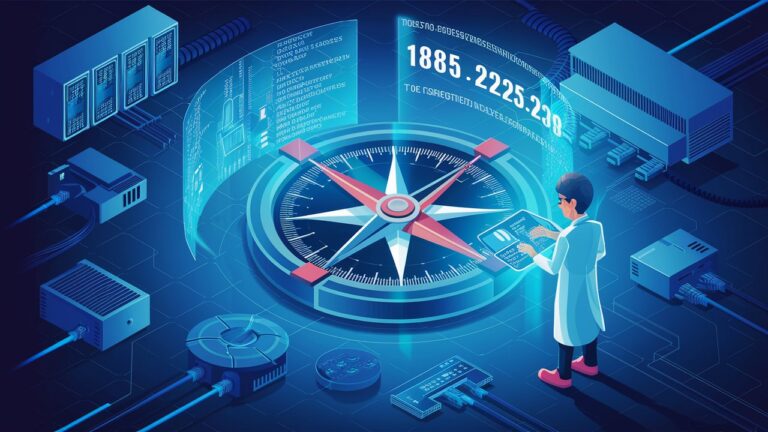Introduction to IP Addresses
In the vast ecosystem of the internet, IP addresses function as fundamental coordinates, guiding data packets to their intended destinations with precision. Every device connected to the internet—whether a smartphone, server, or smart refrigerator—is assigned a unique numerical label known as an Internet Protocol (IP) address. This identifier enables seamless communication across global networks, forming the backbone of digital interactions. Without IP addresses, the internet would collapse into chaos, with data lost in transit and connections rendered impossible. This article explores the structure, evolution, and security implications of IP addresses, demystifying their role in our interconnected world while addressing common pitfalls like the invalid example “185.63.2253.201” provided.
The Anatomy of a Valid IP Address
IP addresses adhere to strict formatting rules, particularly in the IPv4 standard (still widely used today). A valid IPv4 address comprises four octets—numerical segments separated by periods—each ranging from 0 to 255. The example “185.63.2253.201” contains a critical error: its third octet (“2253”) vastly exceeds the 255 limit, rendering it non-functional. This illustrates how even minor syntax errors disrupt network operations. Each octet represents 8 bits of data, allowing IPv4 to support approximately 4.3 billion unique addresses. This structure ensures devices can be uniquely identified and hierarchically organized within networks, facilitating efficient routing. Understanding this anatomy is essential for troubleshooting connectivity issues and configuring network devices correctly.
IPv4 vs. IPv6: Addressing the Exhaustion Crisis
The depletion of available IPv4 addresses spurred the development of IPv6, a next-generation protocol using 128-bit addresses (e.g., 2001:0db8:85a3:0000:0000:8a2e:0370:7334). While IPv4’s 32-bit system is exhausted, IPv6 offers 340 undecillion unique addresses—a near-infinite solution for our expanding digital universe. Despite its advantages, IPv6 adoption progresses slowly due to compatibility requirements and infrastructure costs. Both protocols coexist today, often via dual-stack implementations where devices run IPv4 and IPv6 simultaneously. This transition underscores the internet’s dynamic evolution, balancing legacy systems with innovative scalability to accommodate billions of new IoT devices and global users.
How IP Addresses Enable Global Connectivity
When you visit a website, your device uses the site’s IP address (found via DNS lookup) to initiate a connection. Data packets traverse routers and switches, guided by routing tables that reference IP prefixes. For instance, a request to “172.217.3.206” (Google) hops through multiple networks, with each router inspecting the destination IP to forward packets closer to their target. This process—packet switching—relies entirely on accurate IP addressing. Misconfigured addresses, like our earlier “185.63.2253.201” example, cause “Destination Unreachable” errors, halting communication. Thus, IP addresses act as digital postal codes, enabling precise delivery in milliseconds across continents.
Security Risks and IP Address Vulnerabilities
IP addresses are double-edged swords: they enable connectivity but also expose devices to threats. Cybercriminals scan IP ranges to identify active hosts for brute-force attacks, DDoS assaults, or intrusion attempts. Public IPs (assigned to routers or servers) are especially vulnerable. The invalid “185.63.2253.201” might be a typo, but real IPs in this range could be targeted if associated with insecure services. Additionally, IPs can reveal approximate geolocation, aiding in targeted phishing. To mitigate risks, organizations deploy firewalls to filter traffic by IP reputation, implement VPNs to mask client IPs, and use Network Address Translation (NAT) to hide private internal IPs (e.g., 192.168.x.x) from public exposure.
Best Practices for IP Address Management
Effective IP management prevents conflicts and enhances security. Key strategies include:
- DHCP Reservations: Assign fixed IPs to critical servers via DHCP while dynamically allocating addresses to transient devices.
- Subnetting: Divide large networks into subnets (e.g., 192.168.1.0/24) to isolate traffic and improve performance.
- Regular Audits: Track IP allocations to detect unauthorized devices or configuration drift.
- Geofencing: Restrict access to IPs from specific regions to thwart foreign threat actors.
For the erroneous “185.63.2253.201,” validation tools like online IP checkers or scripting libraries (e.g., Python’s ipaddress module) would flag the invalid octet during input, preventing deployment errors.
Conclusion: The Future of Digital Identification
IP addresses remain indispensable navigational tools in our digital age, evolving from IPv4’s constrained pools to IPv6’s boundless horizons. As 5G and IoT explode, scalable addressing will grow more critical, alongside zero-trust architectures that minimize reliance on IP-based trust. Innovations like encrypted SNI (Server Name Indication) and decentralized identifiers may eventually supplement IPs, but their core function—uniquely locating endpoints—will persist. Vigilance in IP management, combined with protocol advancements, ensures the internet’s infrastructure can securely support humanity’s growing connectivity demands.
Frequently Asked Questions (FAQs)
Q1: Why is “185.63.2253.201” an invalid IP address?
A: IPv4 addresses must have four octets (numbers) between 0 and 255, separated by periods. The third octet here is “2253,” which exceeds 255, violating protocol rules. Correct examples include “185.63.22.201” or “185.63.225.201.”
Q2: Can someone track my physical location via my IP?
A: Only approximately. Public IPs reveal broad details like your city or ISP but not your exact address. Mobile devices and VPNs further obscure location data.
Q3: What’s the difference between public and private IP addresses?
A: Public IPs are unique internet-wide addresses assigned by ISPs. Private IPs (e.g., 10.x.x.x, 192.168.x.x) are used internally within local networks and hidden behind a router’s public IP.
Q4: How does IPv6 improve security over IPv4?
A: IPv6 natively supports IPsec (encrypted traffic), reducing man-in-the-middle risks. Its vast address space also complicates hacker scanning attempts.
Q5: Should I be worried if my IP address is exposed?
A: Exposure alone isn’t critical, but it enables targeted attacks. Use firewalls, update software regularly, and employ a VPN for high-risk activities to mitigate threats.
